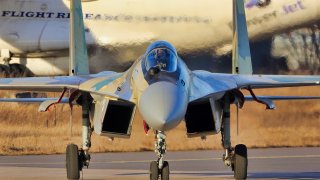Russia's Su-35 Fighter Nightmare Has Just Begun
In the last few months, multiple Su-35s have been shot down, one of which was off the coast of Sevastopol, Crimea.
Summary: The Sukhoi Su-35 "Flanker," an advanced derivative of the Su-27, was designed as a superior multirole fighter capable of air dominance and precision ground strikes. However, its performance in the ongoing conflict in Ukraine has not met expectations.
-Despite its enhanced maneuverability, upgraded radar system, and robust engine power, the Su-35 has struggled to maintain air superiority. Recent reports indicate that multiple Su-35s have been shot down, including a notable incident off the coast of Sevastopol.
-This has contributed to significant losses for the Russian air force, highlighting challenges in its military operations against Ukraine.
Challenges in the Sky: Russia's Su-35 Struggles in Ukraine Conflict
The Sukhoi Su-35 “Flanker” was designed to serve as an advanced multirole fighter that could establish air superiority and execute precise ground strike missions. Yet, over the skies of Ukraine, the Su-35 has struggled to survive.
Failing to establish air superiority
The Russian invasion of Ukraine has made Russian president Vladimir Putin and his regime the pariahs of the international community. Simultaneously, the invasion, which has dragged on ineffectively for over two years, has invited scrutiny of Russia’s military machine. The fact is that the invasion has not gone as planned or expected for Russian forces; Russia was supposed to be able to make significant territorial gains and secure the airspace over the warzone. Yet, as the conflict enters its third year, neither objective has been accomplished.
Russia’s inability to win the airspace over Ukraine is one of the ingredients that has led to a war of attrition, stagnant and viscously fought, where both sides have suffered immense casualties. Russia especially has endured heavy losses with respect to its tanks, troops, and aircraft. One of the aircraft that Russia has had trouble keeping airborne against the pesky Ukrainians is the Su-35.
Derived from the Su-27
The Su-35 is derived from the Su-27. Yet, the Su-35 is visually discernible from its predecessor thanks to the use of canards placed forward of the wings on the fuselage. The Su-35’s canards, plus a reshaped wing leading-edge extension, allows for the redirection of airflow—which has solved a buffeting problem that plagued the Su-27 during flight at high angles of attack.
With the updated flight surfaces, the Su-35 is capable of sustaining flight at up to 10gs. Also, the Su-35’s flight surfaces, along with a sophisticated fly-by-wire system, allow for the jet to achieve enhanced maneuverability over its predecessor.
Additional upgrades include a new weapons-control system, featuring a phase-arrayed radar with pulse-Doppler tracking, known as the N011 Bars. The new N011 Bars allows the Su-35 to track targets below the horizon—which enhances the Su-35’s ability to interact with ground-based targets. Indeed, the N011 offers a significant upgrade over the N001 Myech radar found on the Su-27. Whereas the N001 was only able to track ten targets and fire two missiles simultaneously, the N011 can track fifteen targets and fire six missiles simultaneously.
With two Saturn Al-41F1S turbofan engines providing 30,900 pounds of thrust each (with afterburner engaged), the Su-35 can reach a top speed of Mach 2.25.
The Su-35 Fighter Is in Trouble over Ukraine
While the Su-35 has an impressive array of technological features, the jet has none the less struggled to survive during the Russia-Ukraine war. In the last few months, multiple Su-35s have been shot down, one of which was off the coast of Sevastopol, Crimea.
“Footage online showed a jet on fire, spiraling into the sea and exploding,” reported The Guardian. “The Russian-installed governor of the illegally occupied region, Mikhail Razvoshayev, said on Thursday the pilot ejected and was picked up by rescuers but have no details as to the cause of the crash.”
While the exact cause of the Sevastopol crash may not be clear, the incident is hardly isolated. In February alone, Ukrainian forces downed thirteen Russian aircraft—two of which were the Su-35. “The Russian air force has lost 95 jets since February 2022,” Forbes reported. “That’s four per month.” Yet, in February 2024, “the air force has written off warplanes at a rate of 60 per month.”
About the Author: Harrison Kass
Harrison Kass is a defense and national security writer with over 1,000 total pieces on issues involving global affairs. An attorney, pilot, guitarist, and minor pro hockey player, Harrison joined the US Air Force as a Pilot Trainee but was medically discharged. Harrison holds a BA from Lake Forest College, a JD from the University of Oregon, and an MA from New York University. Harrison listens to Dokken.


